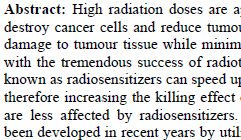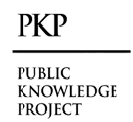Application of Radiosensitizers in Cancer Radiotherapy, Nanomaterials of Heavy Metals, Drugs and Chemicals with Nanostructure
Keywords:
Radiosensitizers, Cancer radiotherapy, Therapeutics, NanomedicineAbstract
High radiation doses are applied in radiotherapy (RT), a cancer treatment, to destroy cancer cells and reduce tumours. The intractable problem of increasing radiation damage to tumour tissue while minimising adverse effects to healthy tissue remains even with the tremendous success of radiotherapy. Chemicals and pharmacological substances known as radiosensitizers can speed up DNA damage and indirectly generate free radicals, therefore increasing the killing effect on tumour cells. Generally speaking, normal tissues are less affected by radiosensitizers. Low-toxicity, very effective radiosensitizers have been developed in recent years by utilising a number of approaches. First, we compiled in this study the uses of radiosensitizers, including those in clinical trials for small compounds, macromolecules, and nanomaterials. Second, a summary is given of the development states of radiosensitizers and potential ways to raise their sensitivity. Third, the opportunities and problems of radiosensitizer clinical translation in cancer therapy are discussed. With considerably less impact on healthy tissues, radiosensitizers are supposed to increase the death of cancer cells. Certain medications target distinct physiological features of the cancer, especially the hypoxia linked to radioresistance. The main hypoxic cell radiosensitizer is oxygen; the attraction of oxic versus hypoxic cells is their considerable differential radiosensitivity. Clinical potential is being shown by the combination of normobaric carbogen breathing and nicotinamide to alleviate acute hypoxia. Hypoxia-associated radioresistance may be universally combated by "electrical-affinic" compounds that react with DNA free radicals; nimorazole, a nitroimidazole, is clinically efficacious at tolerable doses. Tirapazamine and other hypoxia-specific cytotoxins are useful radiotherapy adjuncts. Strong hypoxic cell radiosensitizer nitric oxide is being produced; changes in endogenous amounts may have prognostic value. In theory, many medications can be selectively supplied to hypoxic tumours by activating the release of pharmaceuticals from electron-affinic prodrugs by reductase enzymes or by free radicals generated by radiation. Clinicians are testing a redox-active agent based on a gadolinium chelate. Iodine or bromine modified pyrimidines are integrated into DNA and increase free radical damage; fluoropyrimidines function differently. Many medications that affect the type or repair of DNA damage are being studied in combination with radiation; the processes underlying chemoradiation regimens are frequently unclear. Alkylating drugs include temozolomide; topoisomerase inhibitors (e.g., camptothecin, topotecan) and the hypoxia-activated anthraquinone AQ4N are also being studied. One powerful poly(ADP ribose)polymerase inhibitor under study is AG14361. Along with related kinases (drugs example vandetanib [ZD6474], cetuximab and gefitinib), and cyclooxygenase-2 (celecoxib), proteins involved in cell signalling, such as the Ras family, are intriguing targets connected to radioresistance.
Downloads

Downloads
Published
How to Cite
Issue
Section
License

This work is licensed under a Creative Commons Attribution 4.0 International License.
Current Clinical and Medical Education













